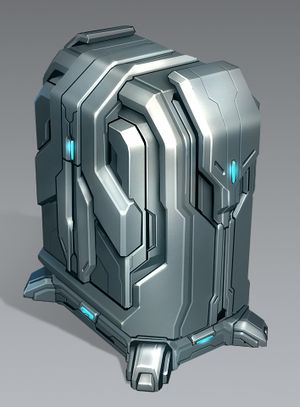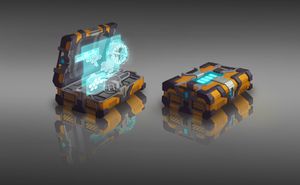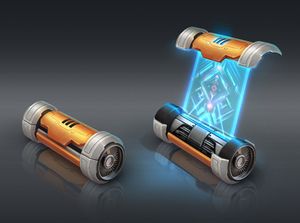



The multinodal core is designed to allow an AI to operate synchronously between multiple devices which are not physically connected with a near-zero lag time between different nodes receiving updated information.
Full Core
A full multinodal core attached directly to primary power and communications systems serves as a centralized server node for an ATP transfer. To avoid transmission errors an AI matrix is stored in sync with the central node via forced subspace entanglement. The transmission channel for a full consciousness transfer is initiated from the central core to a destination through the attached communications system. In addition the full core has fully a fully integrated holographic projection system, it allows an installed AI matrix to directly project itself or any data it wishes in the local area directly from the core itself.
ATP Initialization
The full core is capable of initializing other cores via a direct connection to an uninitialized core. Initialization via subspace is theoretically possible but falls outside the specifications of the ATP.
Redundancy
The full core has dedicated power redundancy as well as its own dedicated transceiver array. This array is secondary to using its connected array but allows the system to function even if the primary array is offline. The redundant power supply within the core itself holds the same purpose.
Diagnostics / Maintenance
A full core is able to perform advanced diagnostics as well as automated repair adjustments to smaller cores as well as manage damaged or power-depleted cores. Smaller cores are only capable of running basic internal diagnostics of their own hardware and software. The full core is capable of running remote diagnostics on any part of the node array.
Component Core
The second and third versions of the core are designed to be a systems component for the Mark I Humanoid Android Body or any other system which has a constraint on component size. Primarily designed to be a component in a single whole device it is small enough to fit within the standard android body head. It does have its own limited reserve power supply as well as a simple diagnostic interface if the device is opened. This does not have an independant transceiver array and is reliant on external components for that. As such the core is capable to be directly connected to nearly any computer terminal directly, but this is not recommended. The core should be installed and not removed unless necessary, the full system it is installed to should handle all communications to and from the core.
The core interface operates as a simple low-resolution holographic display. The engineers can run diagnostics on the core and communication with the AI matrix directly if needed.
Implant Core
The fourth version of the core is designed to be implanted directly into very small or cybernetic systems. Originally developed for use on the XIA body to allow synchronous function of the MSAI in the third version, the fourth version allows the core to be actually implanted directly into a cybernetic system. While the version 3 does not have any kind of an interface to the outside world, the version 4 does. A nano-holographic emitter is installed and this allows for simple diagnostics to be projected even outside of the host device / body it is installed in. Engineers can use this in the case where an AI may be implanted into cybernetics to run diagnostics the host may not be capable of running themselves.
The Version 3 and 4 are both entirely dependant on the host device / body for power and communications.
The version 4 core is a prototype being researched for medical purposes rather than permanent installation into a living host body.
Consciousness Focus
Some AI matrices may find it difficult to operate multiple node locations simultaneously. The system is not designed to allow an AI to operate in an omnipresent way, though it can be used for that purpose. Instead the system is designed to allow an AI to seamlessly switch between different node locations near-instantaneously from any distance. Different AI capabilities and complexities will have different abilities to operate multiple instances of themselves within the same matrix.
Ansible Transit Protocol (ATP)
This communications protocol governs the establishment and use of forced-entangled subspace transmission beams over multiple adjacent subspace domains. The protocol establishes a subspace lock onto a destination device and forms a unique quantum signature node within both the sender and receiver. Each node is then forced into an entangled state using a quantum inversion tunnel. This process establishes a unique connection between nodes through the subspace connection.
Initialization
Each core has a unique quantum identification and is keyed to a specific AI matrix. Once the signatures are keyed during the initialization phase the node's ECC is forced into an entangled state with the ECC within the central core. After initialization the nodes effectively operate as a single core over any distance via the subspace particle entanglement nearly instantaneously. This mutually entangled network with the central core is called the node array.
Intra-Array Transit
An AI matrix need not physically transit between component nodes within the node array as all nodes are synchronous. Thus the node array operates at all locations simultaneously.
Inter-Array Transit
It is not possible to transfer an AI matrix into a node array initialized for another AI. Two AI's would communicate via conventional means or via existing communications channels. A multinodal core must be initialized to one, and only one, AI matrix. Two AI's cannot exist within the same node array.
Extra-Array Transit
An AI may use communications systems to transit out of their initialized node array. The system is designed to keep the matrix synchronous within the array and allow operation of a single AI within disconnected nodes. In some situations it may be required for an AI to transfer their program outside of an array, though any core can do this the ATP attempts to establish a link from the full core to the transit destination if at all possible. The introduction of a system not within the node array will cause lag issues sufficient to desynchronize the remote AI operating outside the node array from the array.
Desynchronization
When the AI matrix in different physical locations goes out of sync with copies at other locations the ATP creates multiple virtual node instances within the central core. These virtual nodes exist as gateways for the AI matrix to relay information to and from the node array, primarily from systems outside the array. By creating virtual nodes the array can have two instances of the same AI matrix running within a singular core while one stays within the array the other is connected outside the array to an external system. This buffer between the array and non-array instances allow the AI matrix remain stable even with different parts are running at different speeds. Any core attached directly, via physical connection, to another computer system should not suffer desynchronization unless the connection quality or stability is low.
Split Array
As a special case of desynchronization an array can be split. If the various cores are forced out of the range of entanglement. This happens during extra-dimensional to extra-temporal travel. During these kinds of transit the system is unable to maintain an entangled synchronous link between parts in different dimensional or temporal zones. Each split of the array functions as it own array. Proper entanglement synchronization resumes after the parts of a split array are within the same zone again.